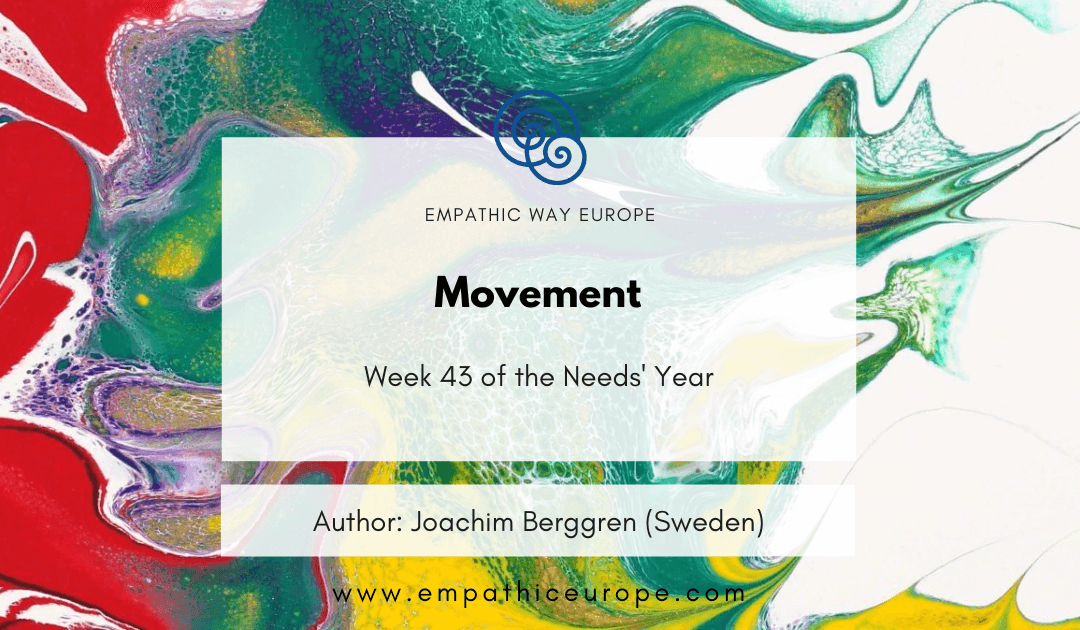I have just increased the weight of the barbell to over 100 kilos. I notice that the body is in tension for the coming weight. Right now, the thought of doing four repetitions of the deadlift doesn’t feel particularly joyful. Knowing that I wouldn’t be doing these exercises if I were guided by my feelings, I grab the bar, tighten my abs, and straighten my legs to lift the weight. Four lifts later, I exhale heavily and rest for a couple of minutes before the next round.
I’m in the gym at my workplace. I’m not particularly strong but I like physical exercise. As I described above, I’m not always delighted by the exercises. What I enjoy though, is the knowledge that I keep my body in shape and that in this way I will probably be able to use my body and my ability to move for many years to come. My everyday life doesn’t involve a lot of physical challenges, so to stay in shape I need to make conscious decisions.
A basic need
In the past when I thought about the need for movement, my thoughts went mainly to cardio and strength training and, to some degree, to flexibility. When reflecting about the need and what to write, my thoughts rather go to our ability to move in general. For example, that we can move, reach for things and crouch down for protection. Instead of just being a need that keeps me healthy and active longer (by exercising), I see it as a basic condition for us as living beings.
If we couldn’t move – or at least if we wouldn’t have people around us with the ability to move – we wouldn’t survive for long. Therefore I would like to group the need for movement together with the other basic survival needs, such as nutrition, water and shelter.
Body language
It’s not only the large body movements that I associate with the need for movement. The fact that we can move and use the body to eat and manufacture things has clear survival benefits. But small movements linked to our body language and facial expressions also have obvious advantages. They reveal much of what goes on inside of us, so individuals with the ability to read these micro-movements are able to anticipate what other people are going to do.
Small movements we are often unaware of are noticed by our unconsciousness and make us act without needing to consciously analyse everything. This bodily function supports us in noticing and potentially fulfils our desires or protects us from dangers. Different sizes of our pupils, a smiling mouth with or without confirmation from the eyes or a frown, all of these send signals about our states of mind to others.
Often it doesn’t matter how hard we try to hide our feelings. Regardless of what we say, our body language will reveal what we feel. Here we get support from NVC. By taking responsibility for our feelings by connecting them to our needs, we can express ourselves honestly. When what we say and our body language match, we become clearer and others don’t have to guess and interpret what we mean.
Beauty
There are also aesthetic aspects of movement. A moving human body can be very beautiful. It can be anything from an infant uncoordinatedly moving its arms and legs, to a dancer performing an act with perfect body control. It is fascinating, inspiring and sometimes scary to see what people can do with their bodies in different fields.
New insights
Thinking about and writing about the need for movement has given me new insights. Knowing that I am constantly signalling my inner state to those around me, I can make conscious decisions about how I want to show up. If I have judgments about myself or others, I will convey this with my body language. Perhaps the easiest way to change my signals is to get in touch with my needs. With the help of self-empathy or empathy, I can find out what I long for and in this way my body language and others’ perception of me will change.
How do you use movement in a conscious way?
Leave a comment below or, if you are a Premium subscriber of “The Needs’ Year”, at the online platform: https://empathiceurope.com/online/courses/the-needs-year/modules/week-43/
Author
Joachim Berggren (CNVC Certified Trainer)
_ _ _ _
On 30 October at 21:00-21:45 CET, you can participate in a Zoom Talk with me and Ryan van der Zanden. We will talk about the need for movement.
Sign up for the Needs’ Year and you will receive a link to Zoom.
If you read this afterward, you can watch the recording when you become a premium subscriber. Check the details HERE.


to start with I want to share the gratitude I feel for you writing about the movement and the perspectives that you see from your exploration. I feel inspired! How do you use movement in a conscious way? I see movement in the aspect of feelings, thoughts and actions. Sometimes I get stuck in some feelings and the way I think of a situation and I need some movement. I then call my friends and share me feelings and thoughts to them and ask to explore together to find perspectives and new strategies. I can call it empathy also and… Read more »
Hi Adam! Thanks for your reflection. My first association of movement is physical movement. Often I use physical movement very consciously. As soon as I wake up I want to move my body. often in a quite gentle way. Maybe by taking a short 10 minutes walk or doing some push-ups- Later in the day I go for a run and a few days in the week I do strength training and yinyoga. Apart from that I try to not be still for too long, maybe just walking half a minute or do some squats before returning to my work.… Read more »